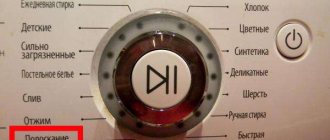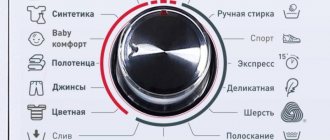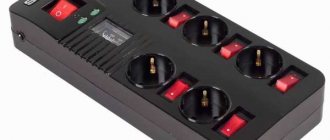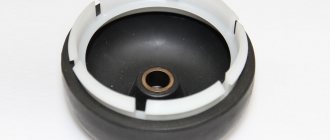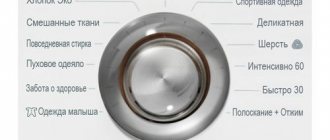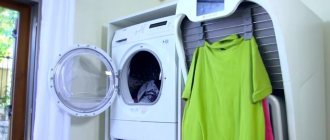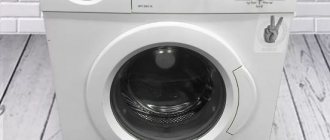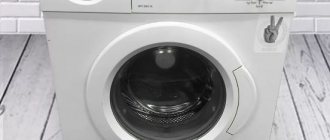Signs on the washing machine help you choose the required type of wash for a particular laundry. This circumstance not only makes the laundry cleaning process more efficient, but also prevents its fibers from destruction. However, not everyone can figure out what this or that designation means.
It is very convenient if there is a short description next to the sign, as on models LG, Samsung, Whirlpool, and so on, but not all washing machines take this circumstance into account. So, let's figure out what the various symbols on washing machines mean.
What is a mode and how is it designated?
The spin mode is designed to remove excess moisture from laundry after washing . This option is included in most wash programs and can also be selected separately on the control panel of the washing machine.
In most washing machine models, this mode is indicated by a curled (twisted) spiral symbol. Also, a number of manufacturers add an additional verbal description to the picture.
The spin intensity itself can be different, determined depending on the choice of program, and takes into account the type of laundry.
Hotpoint-Ariston RSM 601 W
The Hotpoint-Ariston washing machine with an easy ironing function belongs to the class of narrow compact automatic machines with a depth of 42.5 cm. The weight of loaded laundry is much less than expensive machines - only 6 kg, but this model costs half as much as similar premium ones. class. The low price is dictated by energy efficiency class A - this is about 1 kW/hour with a water consumption of 49 liters. The machine also has a higher noise level - 62 dB during washing and 79 dB during spinning.
The budget Hotpoint-Ariston RSM 601 W has a number of additional functions, in addition to “easy ironing”. These are the “anti-allergy”, “dark fabrics”, “down jackets”, “children’s things” modes with other settings useful for a housewife. When necessary, you can load additional items during the washing process—the model has built-in support for reloading laundry. The advantage of the inexpensive “Hotpoint-Ariston” RSM 601 W is protection against leaks and children - additional options for expensive premium models.
Classification
Manufacturers of washing machines produce a wide range of models with different characteristics. There are seven generally accepted spin classes. It is coded in Latin letters: from “A” to “G”. The value of this parameter is determined in the laboratory as a result of tests.
To determine the efficiency index, laundry is weighed before and after washing . Subtract the smaller value from the larger value and divide by the weight of the laundry before washing. The result obtained is converted into percentages. The spin class is one of the criteria for energy efficiency: with intensive rotation of the drum, more intensive electricity consumption occurs.
The efficiency index calculated is decisive for assigning a class. The lower the indicator, the more efficient the washing machine:
Class A. Indicator A is the highest. This efficiency index is achieved by intensive spinning at the highest speeds, when the drum rotation reaches 1,600 rpm. The remaining moisture in the laundry is up to 45%.- Class B. The next most efficient class is B. With it, the residual moisture ranges from 44 to 52%. Processing is achieved by rotating the drum at an intensity of 1,400 rpm.
- Class C. This class is determined by a rotation of 1,200 rpm. At the same time, the laundry comes out of the drum more damp - up to 63%. This indicator indicates sufficient functionality of the washing machine.
- Class D. The residual moisture content of the laundry after this treatment ranges from 63 to 71%. Spinning takes place at an intensity of 1,000 rpm. Class “D” cars are chosen by buyers who are looking for the optimal balance of price and quality.
- Class E. The residual humidity in class E washing machines ranges from 72 to 81%. Spin – 800 rpm. The laundry remains damp after finishing work.
- Class F. Dryness of clothes in class “F” is up to 20%. Spin – low, 600 rpm.
- Class G. This class is inherent in washing machines with low drum rotation speeds. Residual moisture on linen is 90%. As a result, things after such treatment require a long drying time.
In addition to the standard spin cycle, combination washing machines may have a drying function.
Recommendations for choosing a class
Choosing a washing machine based on how fast the drum spins makes you wonder if it's worth paying more to get drier clothes after washing. If drying things in the air is problematic (little space, humid climate, etc.), then a high spin class will be simply necessary.
A and B make the laundry almost dry . But using the option to the maximum can also damage thin and delicate material. If you don’t plan to often use maximum speed, then you can choose a washing machine with a lower class without overpaying for an unclaimed option.
Classes C and D are considered to be European standards. This is the best option for mid-latitudes. The laundry that comes out of the drum is still damp, but can be completely dried by hanging it in the air.
F and G are the most modest option , which is sold in cheap models of washing machines. This washing machine is more suitable for hot regions with high air temperatures.
The classification of spin levels and their letter coding helps to simplify the selection problem and make the right decision when purchasing a washing machine.
To buy or not
After a detailed study of the options, many will refuse such a device. But there's no need to rush. Manufacturers are constantly improving their models, you just need to keep an eye on the new products.
If there are a lot of things in the house that wrinkle a lot, then a washing machine with easy ironing is simply necessary. Of course, housewives will not receive things folded in a pile at the exit, but they will make the ironing procedure easier.
Important! You should not purchase inexpensive automatic machines, because little money was spent on them and the functions will not work well.
How to enable and use the option?
Spin is a function that is included in most washing programs and occurs as follows:
After the wash is completed, the water is drained. The laundry still remains very wet.- The spin cycle starts automatically at a certain intensity.
- The drum begins to rotate at high speed. The removal of moisture from things occurs due to centrifugal force - things in the drum are strongly pressed against the walls.
- The water squeezed out of the laundry is pumped out of the tank using a pump into the sewer system.
This process is quite noisy. This is due to the intense rotation of the drum and the operation of the pump.
Most washing machines allow you to adjust (downward) the spin intensity when choosing standard modes. When the indicator decreases, the laundry will remain more damp than with more intense exposure.
Most equipment manufacturers provide the ability to select spin as a separate program. This is a convenient option; with its help, it is possible to squeeze out items that remain very wet after the standard processing cycle.
You don’t even have to take them out of the drum , but immediately select the “spiral” icon on the control panel.
It is also possible to use the “spin” for hand-washed laundry. Wet items are simply placed in the drum, and the “spiral” is selected on the control panel. At the same time, the intensity of laundry processing can (and even should) be adjusted taking into account the type of fabric and type of items.
Even a powerful washing machine has the ability to select a low speed. This may be necessary when processing delicate, light fabrics that can become deformed, wrinkled, or even tear when the drum rotates intensively. Rotating the drum at high speeds will undoubtedly make the thing drier, but it can also ruin it.
The video will show you how to set only “Spin” on an LG washing machine:
What do we wash and how do we spin it?
When choosing a new washing equipment, you need to pay attention to the number and list of standard programs provided by the manufacturer, and also have the opportunity to change the parameters to suit your requirements, as an option - reduce the spin intensity.
Cotton
Items made from natural cotton are washed at an average temperature of 40-60ºС. Hotter water can cause shrinkage, and in colored materials it can reduce the brightness of the colors. Excess moisture can be removed from cotton items at 800 - 1,000 rpm. and dry additionally while hanging.
Synthetics
Synthetics are most often washed at temperatures up to 40ºС. After this, it can be pressed at an intensity of up to 800 rpm. Experiments with washing temperature and spin intensity are not advisable - things can easily become deformed.
Wool
It is better to wash woolen items either by hand or in a special mode in the washing machine. The processing temperature should not exceed 40ºС . The spin should not be intense, about 400 rpm. Otherwise, things may lose their attractive appearance, become deformed and even shrink.
Delicate fabrics
Most models have a separate mode for washing delicate materials. The washing temperature should not be high - up to 40ºС. Spin – up to 400 or 600 rpm.
Intensive wash
Intensive washing allows you to remove even heavy soiling . Most often it is performed at 60ºC and spin up to 1,000 rpm. But, if the material is mixed, contains wool, or the clothes have complex decor, it is better to limit the temperature to 40ºC.
Kids' things
Depending on the material from which the baby’s clothes are made, a suitable mode is selected.
Cotton underwear and diapers are processed at a temperature of 90ºC. High temperature is needed for effective washing and disinfection .
In this case, the spin can be quite intense - about 1,200 rpm. Since small children’s clothes must be ironed, you can additionally use the anti-crease functionality, which is most often indicated on the control panel as “easy ironing.” This will make further ironing easier.
Fast processing
Items that are not heavily soiled can be refreshed using the “quick wash” mode. Washing takes place at a temperature of no more than 40ºС. It is better to determine the spin intensity taking into account the composition of the material.
Error codes for Siemens washing machines
Modern technology itself informs the owner about the presence of certain malfunctions.
True, she does this not in ordinary human language, but using special character codes on the device’s display. You can easily determine what each of them means from our list. Error F23.
The Aquastop system was activated, signaling the presence of a leak in the machine parts. Until the error is corrected, using the device is strictly prohibited. It is necessary to check the pan in the center of which, as a rule, water begins to accumulate. The main causes of leakage may be damage to the hose or drain pump, or a crack in the tank. After eliminating the malfunction, the error goes away, and the Aquastop system is switched back to monitoring mode.
Error E18.
There is a malfunction in the drainage system. The drain filter may become clogged, a problem may arise in the drainage channels, or some small part may simply fail. If this error occurs, you should immediately stop the water supply and unplug the device from the electrical network. First you need to remove and clean the drain filter, then check if the drain pump is clogged, then return all the parts to their place and try to turn on the machine. If the error remains, the problem is in the control module.
Error E23.
Like error f23, it indicates the presence of leaks. Also, the occurrence of this error may indicate a malfunction of the aquastop system itself - damaged contacts, for example. The repair procedure here is the same as for error f23 - it is necessary to identify and eliminate the reason for the operation of the machine’s protective system.
Error F18.
Problems with draining water. It also warns the owner that the device cannot properly drain the waste fluid. The reason most often lies in blockages; in more serious cases, the control unit is to blame.
Error F18.
Tells us about a breakdown in the drive motor control system. It is necessary to diagnose the engine control relay and replace failed parts.
Error E17.
It usually occurs due to a lack of water at the inlet valve. It is necessary to check the functionality of the solenoid valve by measuring the resistance of the coil.
Error F04.
And again the machine tells us about a leak. The procedure here is the same as for similar errors - we find the leak and fix it.
Prohibitions on using the program
Spin is a useful function, but it cannot always be used. For many types of things and fabrics, this mode cannot be used at all or is possible, but with restrictions.
Such information is indicated on the labels of clothing. In addition, a number of modes built into an automatic washing machine already have a spin limitation program.
If this option is not provided by the program, then, having finished rinsing, the device simply drains the water without performing any further actions.
What to do if the Siemens washing machine does not turn on?
In a situation where the Siemens washing machine does not show any signs of life and does not respond to button presses, you should check the serviceability of the power cord. Disconnect the cord and measure the incoming voltage from the outlet.
The cause may also be a malfunction of the power button. In this case, it must be tested with a multimeter in the on and off state. When the machine is plugged in, you will hear a characteristic sound indicating that the button is OK.
The interference filter that protects the machine from power surges may also break. It is checked with the same device.
If the above checks do not produce results, most likely the control module has failed. It should be replaced.

